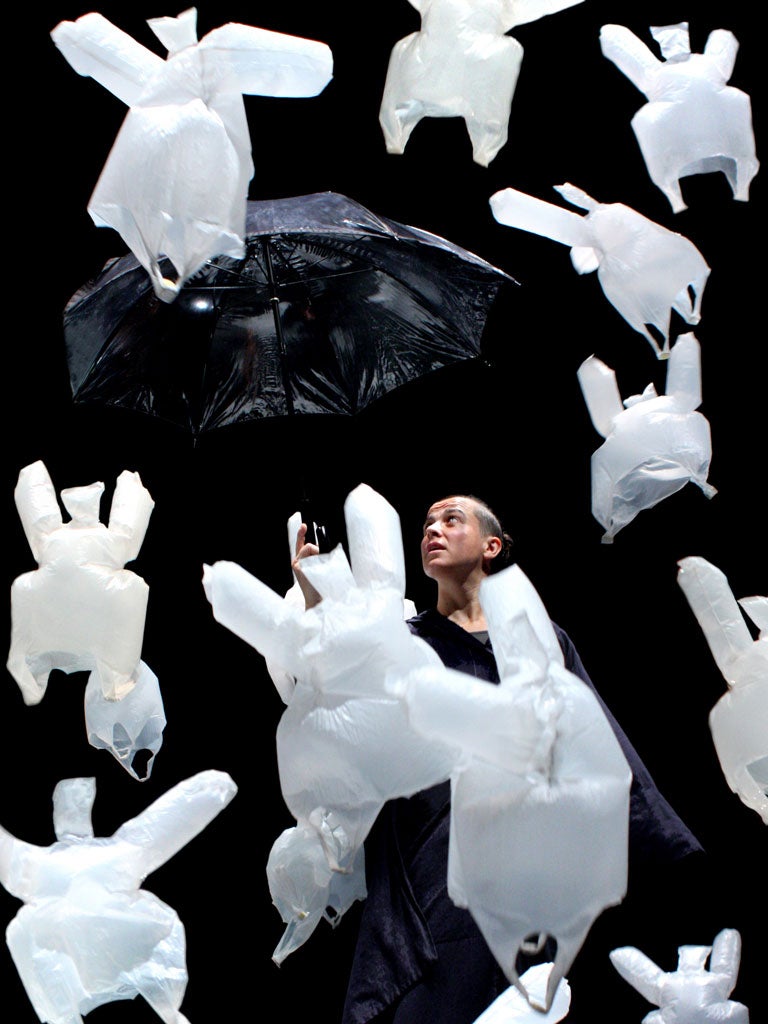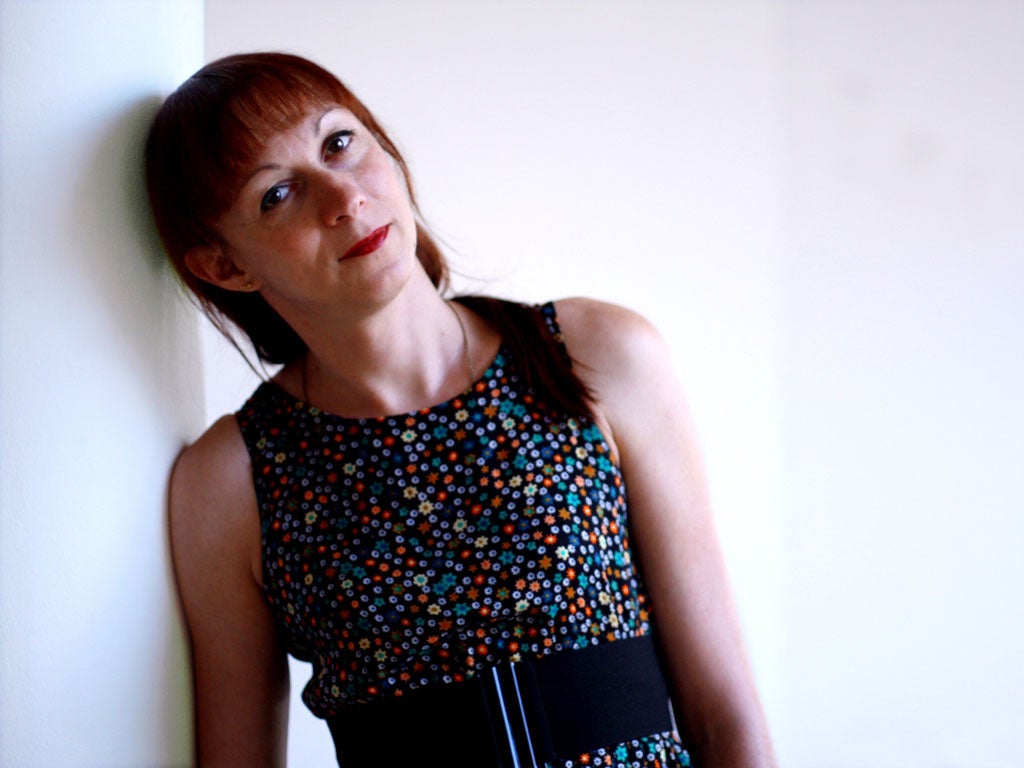Bag lady: Pioneering performance artist Phia Ménard is pushing mime to breaking point
Performance artist Phia Ménard is wowing audiences with ballets featuring unusual, non-biodegradable “dancers”

The London International Mime Festival takes place next month across the capital and, in its 38th year, it promises to be more striking than ever. Forget Marcel Marceau being trapped in a box: since it started in 1977, this festival has consistently pushed the definition of mime to snapping point.
Across this year’s four-week programme one can find juggling, clowning, physical theatre, circus, puppetry, acrobatics, dance and magic. And if evidence were needed of the festival's continued dynamism, it will be provided by two unforgettable shows kicking off proceedings: L’Après-Midi d’un Foehn and Vortex, both the work of the French performance artist Phia Ménard and her pioneering company Compagnie Non Nova.
The first, L’Après-Midi d’un Foehn, was a major critical and audience hit at last summer’s Edinburgh Festival, winning a Total Theatre Award, and it will appeal to both small children and adults. Supermarkets might want to kill off plastic bags, but this show brings them alive, making them morph into beautiful, haunting art. It starts with a silent performer on stage delicately cutting up coloured carriers and then sticking the pieces back together with tape to create human-like figures. Rising into the air, they miraculously start to dance to the music of Debussy, pirouetting, leaping and even holding “hands”.
It looks like a magic trick, but there are clearly no strings attached. Rather, the bags are choreographed by a technician controlling thermal currents by altering the speed of eight fans which circle the stage. Indeed, the title is a gusty pun on L’après-midi d’un faune, a ballet choreographed by Vaslav Nijinsky for the Ballets Russes and also set to Debussy’s music; a “foehn” is a type of warm mountain wind. “It looks like a trick, but I like it that the audience can see that it is real,” says Ménard over tea in a small Normandy hotel on the morning after another mesmerising performance in the round at a nearby theatre.
The second show, Vortex, is a more violent, confrontational, distinctly adult counterpoint to L’Après-Midi … Ménard appears herself this time as “the alien”, dressed in an oversized black suit and bandages like an obese Invisible Man. Costumes are then dramatically peeled away, abandoned layers rising up and blowing around to create more dancing creatures. The result is a breakthtakingly primal depiction of rebirth.

Ménard formed Compagnie Non Nova (motto: “not new, but in a new way”) in 1998, at first to develop her ideas around juggling and add extra risk to the art. In the show PPP, for instance, Ménard juggled balls of ice that were so cold they could cause burns if held for too long but would shatter if dropped. Ménard smiles as she describes her philosophy of pushing the bounds of “injonglabilitié” – “unjugglability”. She also juggled with cacti, pushing herself to the limit and putting herself in constant danger of injury.
Compared to this, and to the dramatic unfurling of Vortex, the dancing bags of L’Après-Midi … are more benign. The initial germ of an idea for the show came from an experience she had while working on a project about movement in the Natural History Museum in Nantes. Walking around the museum in the middle of the night, she was acutely aware of the stillness, and brought in some fans so she could make the fur on the stuffed animals rustle. “The museum suddenly became a graveyard into which I decided to reintroduce life,” she says. Then, on another occasion, the sight of a pink plastic bag floating through the air “like an unexpected visitor” gave her the idea of making bags into balletic creatures.
I ask her if she recalls the scene in American Beauty where a bag, similarly, swirls like a ballerina on the breeze. Ménard has seen it, but says it is just one of those coincidences. Her cultural influences are less mainstream: the rotund physical shape in Vortex comes from the story of Saartjie Baartman, a South African woman with an unusually large derriere who was known as the Hottentot Venus and exhibited around European freak shows in the 19th century, while Ménard was also influenced by the late Leigh Bowery, the subversive performance artist who constantly explored notions of body image.
The subtext behind both shows is the nature of change. In terms of changes within her own life, Ménard has transitioned from male to female in recent years. To what extent do Vortex’s revelations, in particular, relate to this, I wonder? In part, she says. “All my work is about transformation. That is my history. But it is not exactly personal. When we are born and the hand slaps you and says ‘welcome to society’ we try to conform to the law of society so we wear the skin of society. In Vortex, I am asking ‘who is the person inside?’.”
Certainly, one does not need to be aware of Ménard’s personal story to appreciate what takes place on stage. It can be interpreted in a variety of ways: for example, one recent review picked up on the ecological aspect of Ménard’s use of petrol-based, non-biodegradable plastic material, suggesting this spoke of the fact that we, as humans, are more fragile than some of the things we create. Whatever meaning one puts on Vortex or L’Après-Midi … , the one certainty is that their imagery will linger in the mind long after the fans have been switched off.
The next project Ménard has in mind is “something to do with sweat”. When she was growing up, there was a distillery nearby and Ménard was fascinated with the way that drops of alcohol were slowly extracted. Thinking back to it, it reminded her of the way we sweat. “I wonder if our sweat is the best of us, because as a liquid it ties us to nature,” she says. But though, in the future, she might be exploring what comes out of the skin, Ménard has already set the benchmark very high with two shows that truly get underneath it.
‘L’Après-Midi d’un Foehn’ and ‘Vortex’ are at the Platform Theatre, London N1, 8-11 Jan (book online at mimelondon.com). The London International Mime Festival runs from 8 Jan to 1 Feb
Leading the mime wave: Other highlights from the London festival
Jakop Ahlbom & Alamo Race Track: ‘Lebensraum’
Ahlbom, director, actor, mime, acrobat and all-round theatre maker, is joined by cult indie-rockers Alamo Race Track for this piece channelling Buster Keaton’s 1920 short comedy The Scarecrow, and centred on two inventors who are awkwardly co-habiting in one tiny space. Expect highly organised chaos.
Southbank Centre’s Purcell Room, 11, 13, 14 & 15 Jan, 7:45pm, 12 Jan, 3pm
Compagnie Philippe Genty: ‘Forget Me Not’ (‘Ne M’Oublie Pas’)
The celebrated French theatre director, artist and puppeteer returns to the festival with a new version of this classic and seasonal piece set in a wintry dreamscape that’s full of snow, magic and Scandinavian mystery.
Queen Elizabeth Hall, 17 and 18 Jan, 7:30pm, 19 Jan, 5pm
Compagnie 111/ Aurélien Bory: ‘What’s Become of You?’ (‘Questcequetudeviens?’)
The UK premiere of Bory’s creation for flamenco soloist, Stéphanie Fuster, tells the contemporary story of an artist in search of herself, through the traditional elements of dance, live vocals and guitar.
Barbican, 30 Jan to 1 Feb, 7:45pm
Compagnie Mpta/ Mathurin Bolze – ‘A Bas Bruit’
French New Wave filmmaker and anthropologist Jean Rouch, inspired Bolze’s latest show (right), which combines video, dance, and circus performance to tell a story of rebellion. A Bas Bruit is the follow-up to Du Goudron et des Plumes, which earned Compagnie Mpta and Bolze five-star reviews and two sell-out runs at the Barbican.
Linbury Studio Theatre, Royal Opera House, 9 & 10 Jan, 7:45pm, 11 Jan, 6pm (mimelondon.com)
Emma Finamore
Join our commenting forum
Join thought-provoking conversations, follow other Independent readers and see their replies
Comments